Here's a short (2 minute) NASA video on a laser-driven interstellar swarm, published a few months ago... ( Thanks to @bargill33.bsky.social for the link !) youtu.be/XXW_keR5OIM?...

youtu.be
Swarming
YouTube video by NASA Space Tech


We live during an ongoing revolution in the discovery of exoplanets–planets beyond our solar system–leaving many wondering what these worlds look like. Current propulsion technologies, such as chemical rockets and electric propulsion, are impractical to reach even the nearest exoplanets, and the size of a telescope that could image an exoplanet would be unrealistically large, exceeding the size of the earth. These two factors have stimulated interest in propulsion methods that have the potential to reach the stars.
Our mission is to contribute to this international effort by designing, analyzing, and lab-testing alternative flight methods capable of achieving a significant fraction of the speed of light. Our group has a particular interest in directed energy propulsion like lightsails, intermediate steps toward this technology–such as laser-thermal propulsion–that would open our solar system, and propulsion methods that would exploit sources of energy freely available in space. Additionally, we are committed to engaging future students of science and engineering with these emerging technologies and connecting them to the international community of interstellar researchers, generating a stream of new minds aligned to realizing interstellar flight in this century.
Here's a short (2 minute) NASA video on a laser-driven interstellar swarm, published a few months ago... ( Thanks to @bargill33.bsky.social for the link !) youtu.be/XXW_keR5OIM?...

youtu.be
Swarming
YouTube video by NASA Space Tech
Big new (at least for me): I’m on sabbatical leave from McGill this year and working full-time with General Fusion in Vancouver. With 2026 shaping up to be a pivot year for commercial fusion, I’m excited to be on-site and contributing directly to the effort.

www.linkedin.com
Welcome to General Fusion, Dr. Andrew Higgins! General Fusion and McGill University have collaborated for over a decade, and we’re thrilled to welcome McGill Professor Andrew Higgins to our team… |...
Welcome to General Fusion, Dr. Andrew Higgins! General Fusion and McGill University have collaborated for over a decade, and we’re thrilled to welcome McGill Professor Andrew Higgins to our team du...
Someone was asking what the interstellar medium around the Sun looks like in 3D. Here's a quick render. I might add an improved version of this to a room in my Star Central VR world. Brown: dust, red: ionized gas, blue: hot stars.

Unfiltered glimpses of our solar system revealed through raw, breathtaking images. Our group works with one goal in mind: to someday capture such images from other solar systems.
October 11, 2025 at 3:07 AM UTCNow on @sciam.bsky.social: NASA’s next-gen Habitable Worlds Observatory may be our best chance to find alien life. But can a nation busy ripping itself apart unite to launch a mission to solve life’s cosmic mysteries? By @nadiadrake.bsky.social (and me). www.scientificamerican.com/article/are-...

www.scientificamerican.com
NASA’s First-Ever Alien-Hunting Space Telescope Could Enlighten Our New Dark Age
The Habitable Worlds Observatory is poised to tell us whether Earthlike planets are common—if it can get off the ground
“How a Billionaire’s Plan to Reach Another Star Fell Apart” Our group is still at it, stubbornly in the trenches, steadily chipping away at the key problems that must be solved to reach the nearest stars. The work continues. Onward! www.scientificamerican.com/article/the-...

www.scientificamerican.com
A $100-Million Mission to Another Star Just Disappeared
An abandoned plan to visit another star highlights the perils of billionaire-funded science
Now on @sciam.bsky.social: For the 1st time, we’ve seen hints of an atmosphere around a potentially habitable exoplanet. If confirmed, this would be a monumental discovery, opening a new era in the search for life beyond Earth. By @astrojonny.bsky.social. www.scientificamerican.com/article/jwst...

www.scientificamerican.com
Why a Hint of an Atmosphere on this Alien Planet is Such a Big Deal
A monumental sign of an atmosphere on TRAPPIST-1e could be the precursor to finally finding a living world around another star
Jake Kurlander - talking about the predicted LSST asteroid and TNO discoveries - 80% Solar System small bodies will be discovered in the first two years #EPSCDPS2025
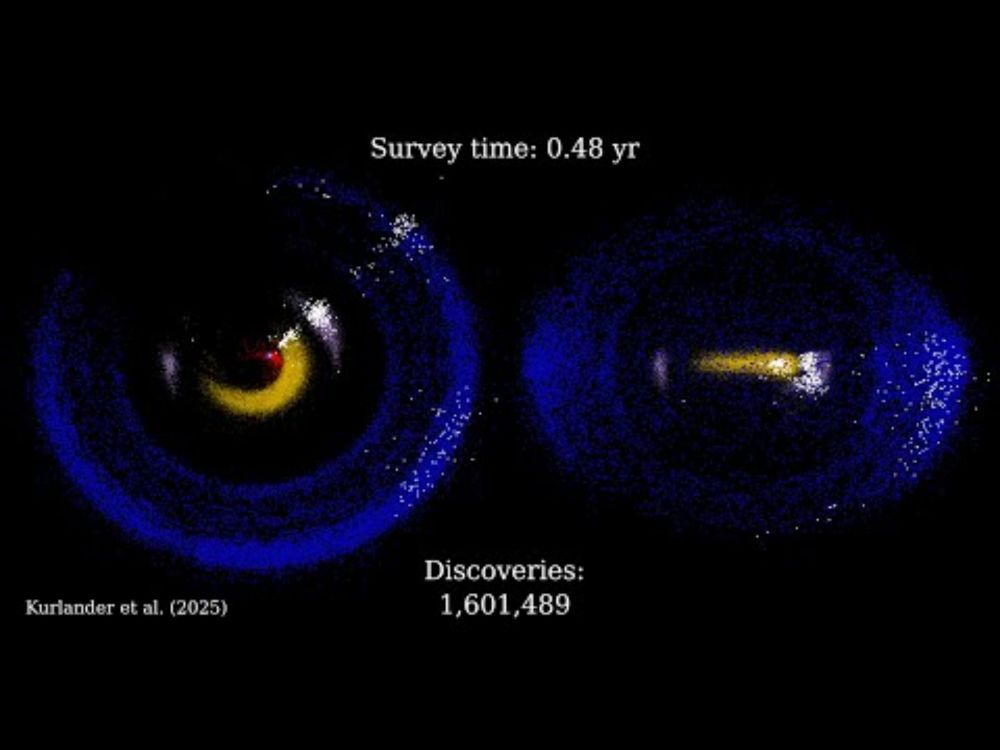
www.youtube.com
Simulated Solar System Discoveries of LSST
YouTube video by Jake Andrew Kurlander
Michelle's final paper investigates interstellar objects (such as the 3 detected interstellar comets) for signs of alien technosignatures! So far, all 3 objects are comets, but if there were a probe out there, how could we find out? This paper outlines the methods. 🔭 ☄️ arxiv.org/abs/2508.16825

We’re reading “Lightsails for Interstellar Travel: Photonics for Propulsion, Thermal Management and Stability” pubs.acs.org/doi/10.1021/...

pubs.acs.org
Lightsails for Interstellar Travel: Photonics for Propulsion, Thermal Management and Stability
Lightsails are a highly promising spacecraft concept that has attracted interest in recent years due to its potential to travel at near-relativistic speeds. Such speeds, which current conventional cra...
Issue 50 of Principium is now published - Lead Feature : BOOK REVIEW, The Ross 248 Project. - Project Hyperion - Breakthrough Disc - "Where do you look for ET" - IAC25 - The Journals - Interstellar News .. and more ! Read it here : - i4is.org/principium-50/ Editor: @johninghamdavies.bsky.social
i4is.org
Principium 50
Principium 50 – Contents LEAD FEATURE BOOK REVIEW The Ross 248 Project (<a href="https://i4is.org/wp-content/uploads/2025/08/BOOK-REVIEW-The-Ross-248-Project-Principium50-2508261234.pdf">https://i4is...
Reduce the radiation load by more than half, increase efficiency by 20% and make ignition easier by using spin-polarization in a fusion rocket, which aligns the DT fuel atoms and make their neutron release directional. By @gbruhaug.bsky.social: arxiv.org/pdf/2108.01211



Technosignature Searches Of Interstellar Objects astrobiology.com/2025/08/tech... #astrobiology #3IATLAS #interstellar #SETI

astrobiology.com
Technosignature Searches Of Interstellar Objects - Astrobiology
With the discovery of the third confirmed interstellar object (ISO), 3I/ATLAS, we have entered a new phase in the exploration of these long-predicted objects.
Congratulations to Space Concordia Rocketry Division on the successful launch of Starsailor, featuring the largest student-built bipropellant rocket engine ever flown (35 kN thrust). The launch occurred approximately 1 hr 16 mins into the livestream linked below. www.youtube.com/live/610YciE...
l.facebook.com
We're reading (and hoping for a successful flyby target🤞🤞): "An Extremely Deep Rubin Survey to Explore the Extended Kuiper Belt and Identify Objects Observable by New Horizons" by @megschwamb.bsky.social doi.org/10.3847/1538...
doi.org
Radware Bot Manager Captcha
To ensure we keep this website safe, please can you confirm you are a human by ticking the box below.
Why were we able to see the spiral rocket plume last night, but not during other rocket launches? The time of day, the Sun’s light, and the direction the rocket heads into space causes this effect…

One of the members of our research group was out watching the Perseids on Tuesday night in Montreal and captured these images of the plume.


A Saturn mass gas giant may be orbiting Alpha Centauri A, based on solid JWST infrared results and exhaustive simulations of its orbit. It's still a candidate rather than a confirmed world, but follow-up work will tell us soon. www.centauri-dreams.org/2025/08/08/a...
www.centauri-dreams.org
A Candidate Gas Giant at Alpha Centauri A | Centauri Dreams
Direct images from the James Webb Space Telescope show what could be a Saturn-mass planet around Alpha Centauri. skyandtelescope.org/astronomy-ne... . . #astronomy #exoplanets #planetaryscience #cosmology #alphacentauri #jwst #newplanet

skyandtelescope.org
Alpha Centauri Might Have a Planet, Webb Telescope Finds
Direct images from the James Webb Space Telescope show what could be a Saturn-mass planet around Alpha Centauri.
I have a complaint about Avi Loeb's latest work and I want to speak to management. medium.com/@steve.desch...
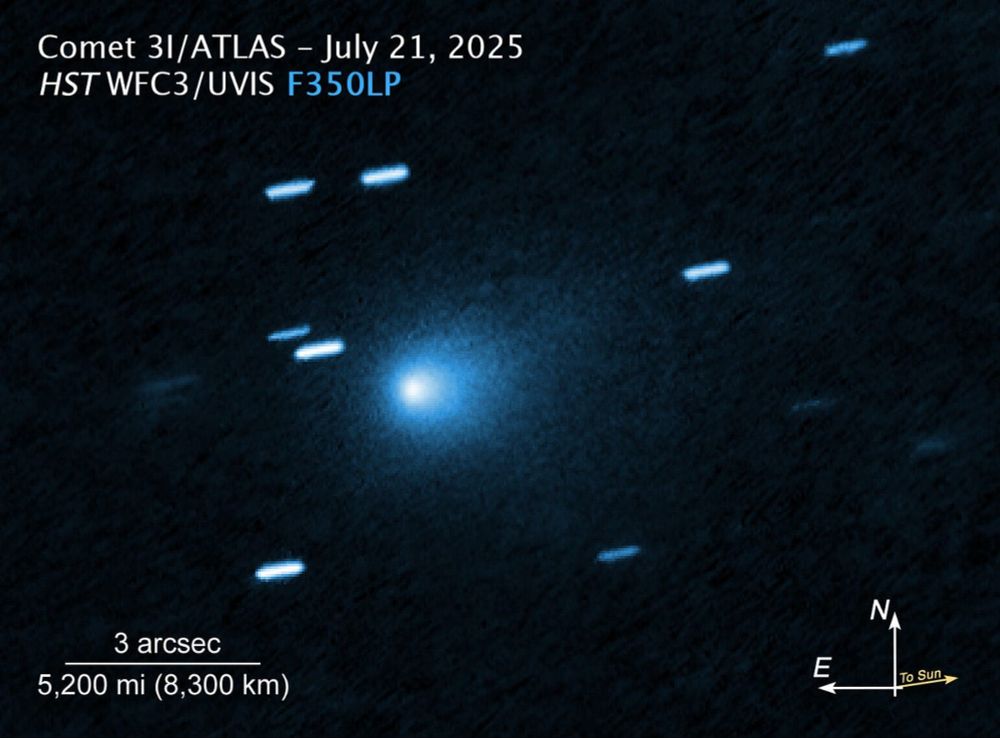
medium.com
This is not the quality of pseudoscience infotainment to which I have grown accustomed
Teasing the public with fraudulent or self-deluded promises of aliens used to mean something. It took work. It meant slapping together…
After years of searching, astronomers have found strong evidence of a planet around Alpha Centauri, a near-twin of our Sun in the nearest neighboring star system. This would also be the closest exoplanet ever observed directly. 🧪🔭 webbtelescope.org/contents/new...
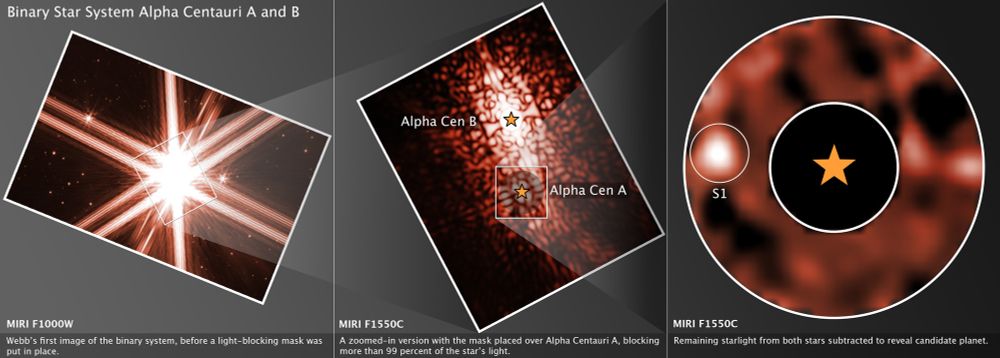
Now on @sciam.bsky.social: Using JWST, astronomers have spotted what seems to be a gas giant planet in the habitable zone of Alpha Centauri A, the nearest sunlike star to our solar system. This is *huge* if true. By @meghanbartels.bsky.social. www.scientificamerican.com/article/jwst...

www.scientificamerican.com
Astronomers Are Enthralled by This Potential Planet around Alpha Centauri
In some of its most ambitious work yet, the James Webb Space Telescope looked to spot a planet in a potentially habitable orbit around Alpha Centauri A, the nearest sunlike star to our solar system
It gets worse and worse. If you're interested in the slow-motion train wreck that is Avi's sci-comm on this, here are some of the latest (it's very hard to keep up!) In which spacecraft can have comae, 3I/ATLAS has a 60% chance of being alien, and new papers validate and adopt his calculations.
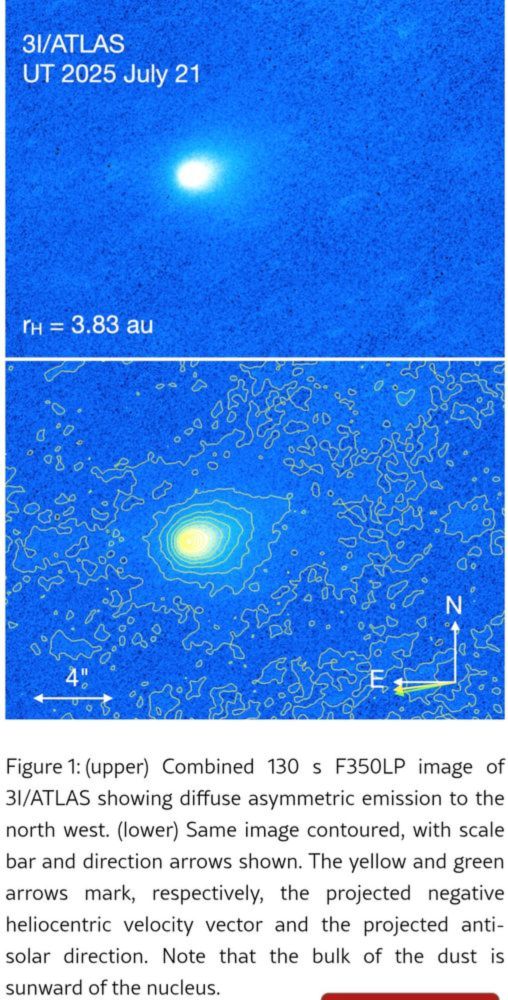
sites.psu.edu
More Avi and 3I/ATLAS
Following up on this and this: Today images from the Hubble Space Telescope were published by Jewitt et al., and they show the coma of 3I/ATLAS very well: Would this be enough to convince Avi that it’...
🌌 Announcing the Winners of the Project Hyperion Design Competition 🌌 ... hosted by i4iS. Can we imagine a society that thrives on the journey to the stars? 🏆 Winners 🥇 Chrysalis 🥈 WFP Extreme 🥉 Systema Stellare Proximum Plus 10 mentions... Full details are here : www.projecthyperion.org
www.projecthyperion.org
Project Hyperion | interstellar generation ship design competition
Project Hyperion explores the feasibility of crewed interstellar travel via generation ships, using current and near-future technologies. A generation ship is a hypothetical spacecraft designed for lo...
New paper! Allow me to introduce TARS = Torqued Accelerator using Radiation from the Sun. TARS (yes inspired by Interstellar!) is a rotating light sail that's capable of launching chip sats into interstellar space using only radiation from the Sun, so let's dive into how it works.

Lots of news just came out about strange, rhythmic goings-on in the outer regions of our solar system. An object called 2020 VN40 moves in sync with Neptune (1 orbit for every 10 of Neptune), suggesting a large population of bodies in similar resonances. 🧪🔭 www.cfa.harvard.edu/news/astrono...
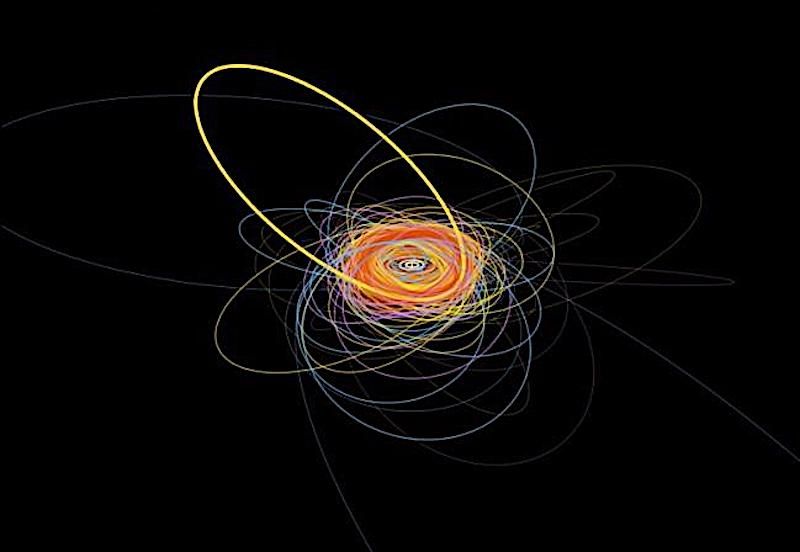
It's paper day! The first science paper with data from @vrubinobs.bsky.social's survey camera, the mighty LSSTCam, is a VERY quick turnaround of Rubin's observations thus far of interstellar comet 3I/ATLAS. ☄️ Chandler et al., submitted 🔭 A 🧵

arxiv.org
NSF-DOE Vera C. Rubin Observatory Observations of Interstellar Comet 3I/ATLAS (C/2025 N1)
We report on the observation and measurement of astrometry, photometry, morphology, and activity of the interstellar object 3I/ATLAS, also designated C/2025 N1 (ATLAS), with the NSF-DOE Vera C. Rubin ...
On Avi and 3I/ATLAS: sites.psu.edu/astrowright/... ☄️ 🔭
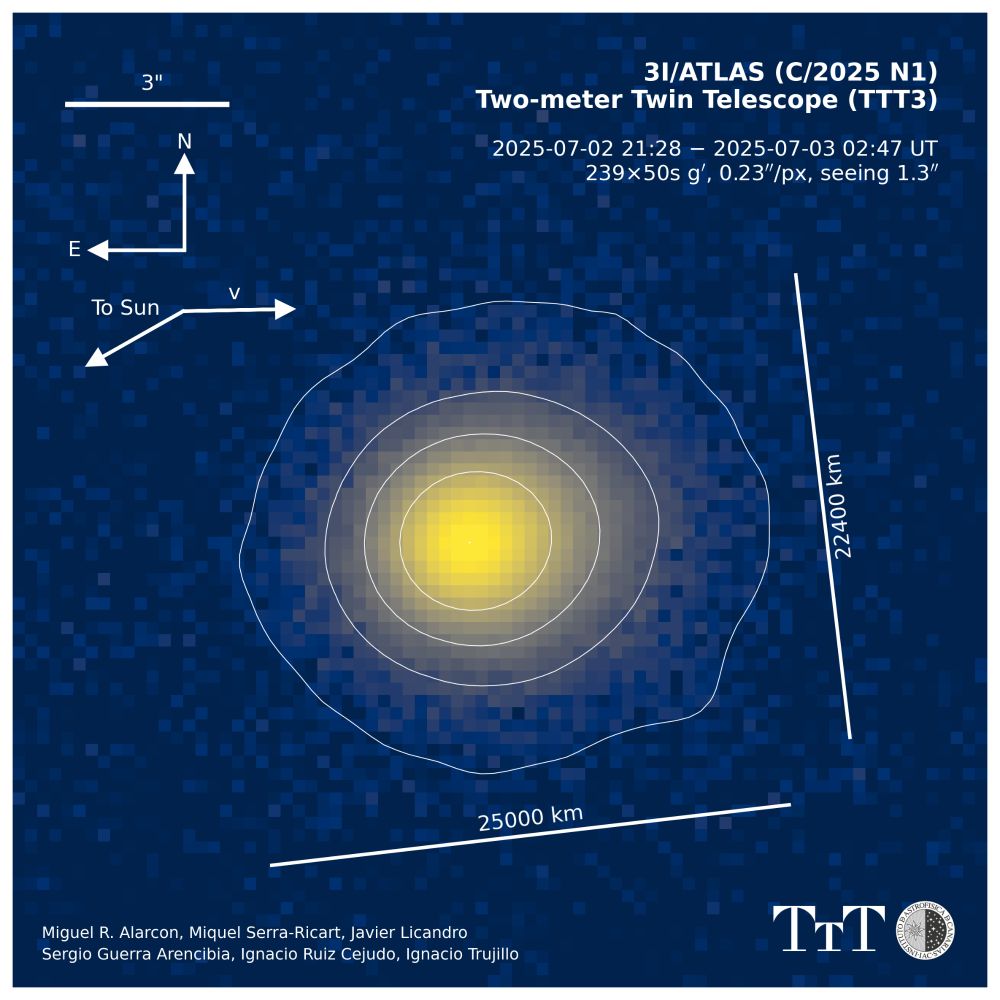
sites.psu.edu
Avi and 3I/ATLAS
Avi Loeb has gained a reputation for suggesting and outright claiming things could be alien spacecraft even when there’s little to no objective reason to think so. So when the third interstellar objec...
The preview of 'Laser Propulsion in Space' has an excellent introduction: books.google.co.uk/books?id=9Cf... It could offers variable 1000-10,000 Isp and good thrust/watt performance, but its strongest advantage is how the heavy generator and spacecraft can be separated by long distances.




The dragon is dead. breakingdefense.com/2025/06/darp... The DRACO nuclear thermal rocket program has been terminated by DARPA. Reasons cited: -SpaceX Starship will deliver so much propellant into orbit that fuel efficiency won't matter -Future nuclear-electric propulsion could be more promising

Fusion starships from BIS: indico.esa.int/event/309/at... There's the classic Daedalus, the Icarus pinning its hopes on Ultra-Dense Deuterium, the mind-boggling Firefly and now the 'Ghost' using a plasma-jet magneti-inertial fusion drive to reach 0.05C then stop at its destination.




Ultimately, the speed of light is not an obstacle to human interstellar travel. As this thread has shown, it is relativity that *enables* journeys between stars within the span of a human lifetime. [9/9]
July 17, 2025 at 2:28 PM UTCIt’s not something we’ll see in our lifetimes, which is why our research group doesn’t spend time working on relativistic space travel. We stay focused on feasible, near-term steps. But, if physics doesn’t forbid it—and if people want to do it—it’s worth thinking about. [8/9]
July 17, 2025 at 2:28 PM UTCOf course, the energy demands of such a mission are enormous. To exploit relativistic time dilation, propulsion must overcome relativistic mass increase. There’s no free lunch. [7/9]
July 17, 2025 at 2:28 PM UTCThis isn’t “faster than light” travel in any technical sense; it’s a consequence of special relativity. What appears paradoxical is just a matter of how time behaves at relativistic speeds. [6/9]
July 17, 2025 at 2:28 PM UTCAccelerating to speeds exceeding 92% of light speed, the crew experiences even less time than it takes light to cross the same distance. From the crew’s reference frame, they are effectively traveling “faster than the speed of light,” without violating physical laws. [5/9]
July 17, 2025 at 2:28 PM UTCFor example, traveling to a star 10 light-years away would take 10 years from the crew’s perspective, though observers back on Earth would see the journey take longer due to time dilation. The onboard clock just ticks differently. [4/9]
July 17, 2025 at 2:28 PM UTCIf a spacecraft could accelerate to 92% the speed of light and decelerate to rest at its destination, relativistic time dilation means the crew experiences a duration equal to the distance traveled in light-years. [3/9]
July 17, 2025 at 2:28 PM UTCEven without radical life extension or humanity transferring in silico, there’s no physical law preventing travel—even roundtrips—to distant stars in a current human lifetime. How? [2/9]
July 17, 2025 at 2:28 PM UTCOur group focuses on near-term technologies for the first robotic forays beyond our solar system. But it’s worth addressing the oft-repeated claim: “The speed of light is a hard limit: You can’t travel to the stars in a lifetime, so it won’t happen. [1/9]
July 17, 2025 at 2:28 PM UTC3I/ATLAS is the third interstellar object we've identified. Almost surely a comet, it's moving toward perihelion in October, and is already active as its surface warms. We'll learn a great deal more about it as this process intensifies. Thoughts on ISO's: www.centauri-dreams.org/2025/07/10/3...
www.centauri-dreams.org
3I/ATLAS: Observing and Modeling an Interstellar Newcomer | Centauri Dreams
Go to my latest starship blog for the Initiative for Interstellar Studies (i4is), concerning missions to the third interstellar object to be discovered, 3I/ATLAS: @i4interstellar.bsky.social i4is.org/missions-to-...
i4is.org
Missions to 3I/ATLAS
Subthread 🧵:what does VLT/MUSE show us about interstellar object 3I/ATLAS? Plenty! First: 3I has a coma, so it is also a comet. Here's the 'white light' (summed whole-MUSE-wavelength range) deep stack image of our observations on July 3 🔭

quick scicomm: we get interstellar objects in the Milky Way because we are In the MW: it's primarily a direction of travel effect (there's more, but for that, see technical discussion linked) 🔭
July 5, 2025 at 9:37 PM UTCThe Nautilus array of space telescopes, using fresnel diffractive lenses that are 8.5m wide yet 10x lighter than same-sized solid glass lenses, working together to act like a 50m wide telescope to find 1000+ earth-like exoplanets within 1000 ly: arxiv.org/pdf/1906.05079




Our students achieved another successful high-altitude balloon flight last night in collaboration with @uvic.ca and with support from the CSA’s FAST program. Onward and upward!
July 5, 2025 at 12:45 PM UTCSuccessful payload recovery! After a long night, we located and recovered the payload 52 km from the launch site.

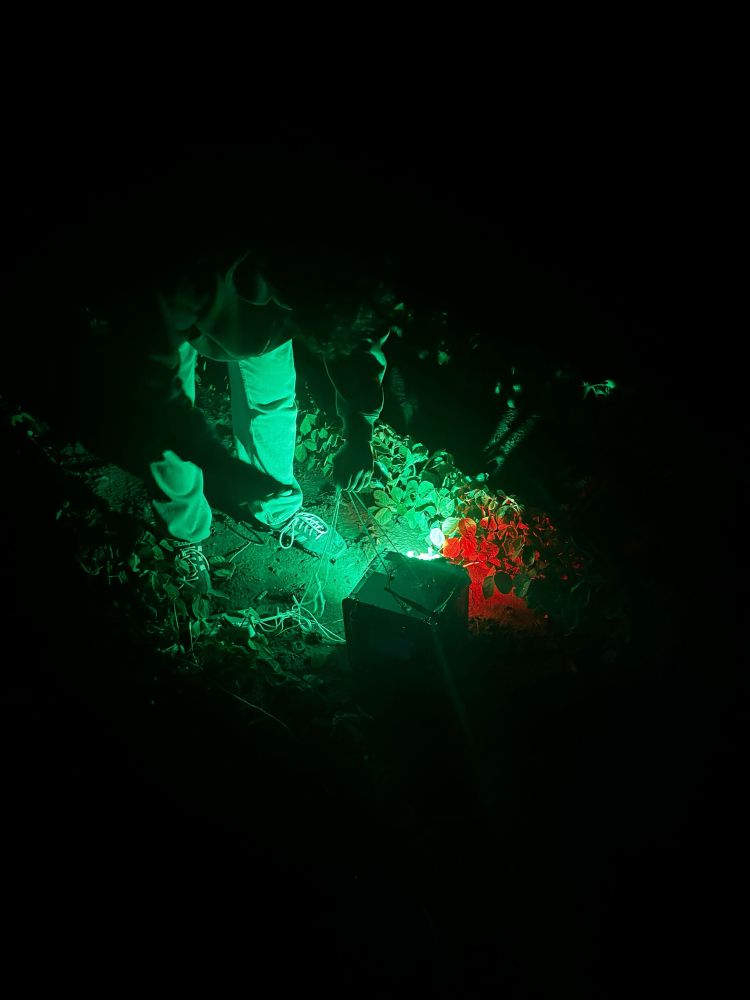
Inflation complete. If you’ve never done this before, launching a balloon—even a small weather balloon—isn’t as trivial as it sounds; it demands extraordinary coordination among the team.

With flight preparations complete, all that’s left is to sit back, chill, and wait for our launch window to open at sunset.

In addition to a new Iridium-based tracker, we’ll be using our own LoRa-based line-of-sight telemetry to track and control aspects of the flight.

Our high-altitude balloon launches have been on hold for months as we worked around a fault in our once-trusty Globalstar-based tracker (which recently proved far from trusty). Having resolved the issue, we’re ready to fly high again tonight from a remote site north of Montreal.

Reminder: At any time, dozens of comets cross into our inner solar system. The discovery of interstellar visitor 3I/ATLAS deservedly excites us, but I'm seeing the tropes of “nature’s wake-up call” or “the dinosaurs didn’t have a space program.” Comets are *always* zipping in. /1
July 4, 2025 at 1:36 PM UTCNow on @sciam.bsky.social : Detected on July 1, the comet 3I/Atlas is only the third interstellar object ever witnessed passing through the solar system. It'll have its closest approach to the sun on October 30. Nice piece by @norabradford.bsky.social www.scientificamerican.com/article/new-...

www.scientificamerican.com
Third Interstellar Object Swoops through our Solar System, Surprising Astronomers
All eyes are on Comet 3I/Atlas as astronomers worldwide chase the exotic ice ball through our solar system
New paper on interstellar comet #3I/ATLAS is out on arXiv! By Darryl Seligman and more. Images show a fuzzy tail, and the comet's dusty coma is similarly reddish like the other interstellar comet 2I/Borisov. arxiv.org/abs/2507.02757 ☄️🔭🧪


UPDATE ON INTERSTELLAR COMET #A11pl3Z: It's OFFICIALLY LABELED 3I/ATLAS by the Minor Planet Center!!! minorplanetcenter.net/mpec/K25/K25... HUGE thank you to all the astronomers for confirming this object! The next step now is someone getting the big scopes (Hubble, JWST, etc.) to look at it! ☄️🔭🧪

It’s offical: the Minor Planet Centre record 3I/Atlas - the third interstellar visitor detected in tge Solar System. Very tentative reports of cometary activity, much more to come minorplanetcenter.net/mpec/K25/K25...
minorplanetcenter.net
MPEC 2025-N12 : 3I/ATLAS = C/2025 N1 (ATLAS)
We are the official body that deals with astrometric observations and orbits of minor planets (asteroids) and comets.
FACT THREAD on New Interstellar Object #A11pl3Z This story unfolded pretty fast yesterday for a few reasons. The object was discovered on July 1st UTC by the Asteroid Terrestrial-impact Last Alert System, or ATLAS team. A #NASA funded survey at the University of Hawaii. atlas.fallingstar.com 🔭🧪
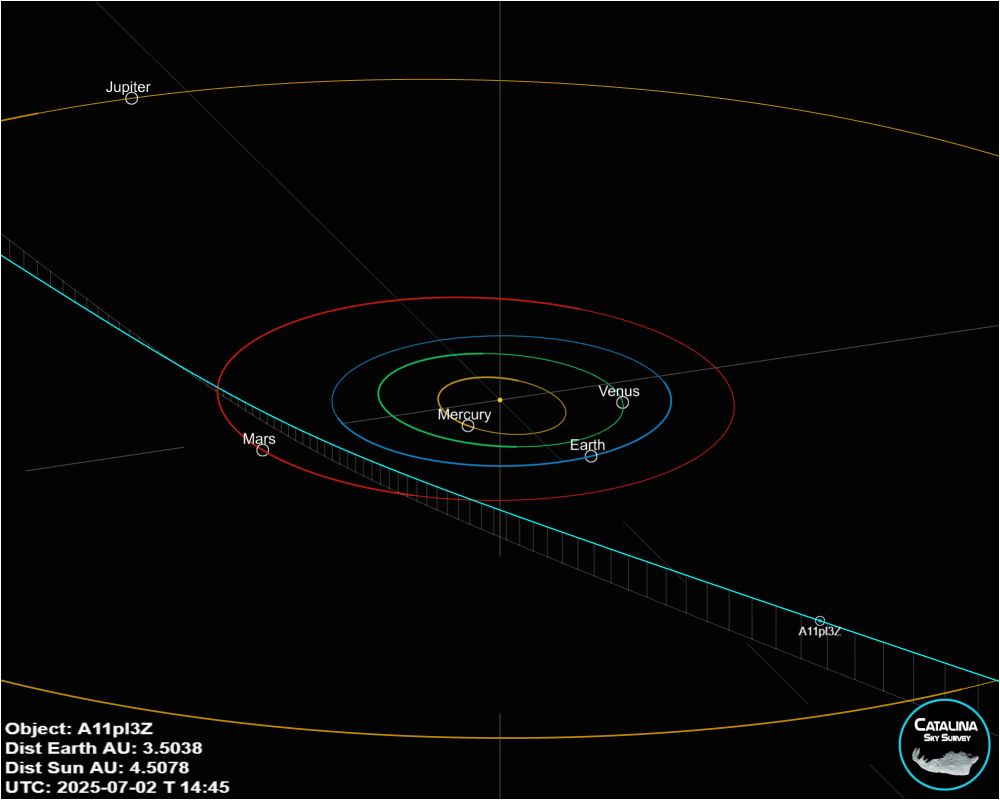
Only the third ever interstellar object: a tiny world that started its existence at another star. Now cruising in toward our Sun at ~58 km/s, a faint dot (V~18) in the Southern skies. What a day 🔭
July 2, 2025 at 1:51 PM UTCAstronomers may have just discovered the third interstellar object passing through the Solar System! ESA’s Planetary Defenders are observing the object, provisionally known as #A11pl3Z, right now using telescopes around the world.
July 2, 2025 at 8:23 AM UTCThis could be interesting, especially if @adamsspaceresearch.bsky.social can find a good spacecraft rendezvous option ...
July 2, 2025 at 10:55 AM UTCFor any asteroid observers who have not heard about it already: Newly-discovered #A11pl3Z is a candidate interstellar object. cneos.jpl.nasa.gov/scout/#/obje...
cneos.jpl.nasa.gov
Scout: NEOCP Hazard Assessment
NASA's Near-Earth Object (NEO) web-site. Data related to Earth impact risk, close-approaches, and much more.
3rd interstellar object discovered? Maybe. There's a lot of buzz right now in the Astro community. More observations should come in tonight to confirm if A11pI3Z is from beyond the solar system.

Here's our images of interstellar object #A11pl3Z from Deep Random Survey's 0.43-meter scope @ Chile. The telescope was following A11pl3Z's motion, so stars appear smeared. Weather got worse by the end, so still hard to tell if it's a comet. 600-sec exposures, from 2025 Jul 2, 00:42-01:23 UT 🔭☄️

Using a direct fusion drive as being designed at Princeton for a Sedna orbiter. Interesting conceptual analysis & feasibility study, contrasting this option with a solar sail using desorption, blowing off embedded elements at perihelion. Hint: sail is faster. www.centauri-dreams.org/2025/07/01/a...
www.centauri-dreams.org
A Sedna Orbiter via Nuclear Propulsion | Centauri Dreams
New Horizons is so far away that the nearest stars have shifted markedly from where we see them on Earth. With the NH observed positions for two stars, from NH imagery alone we can figure out where the spacecraft is. This technique would be used on interstellar voyages. arxiv.org/abs/2506.21666

arxiv.org
A Demonstration of Interstellar Navigation Using New Horizons
As NASA's New Horizons spacecraft exits the Solar System bound for interstellar space, it has traveled so far that the nearest stars have shifted markedly from their positions seen from Earth. We demo...
@nytimes.com article about Nate Kaib's and my recent paper on the future stability of the Solar System when passing stars are accounted for. www.nytimes.com/2025/06/28/s...
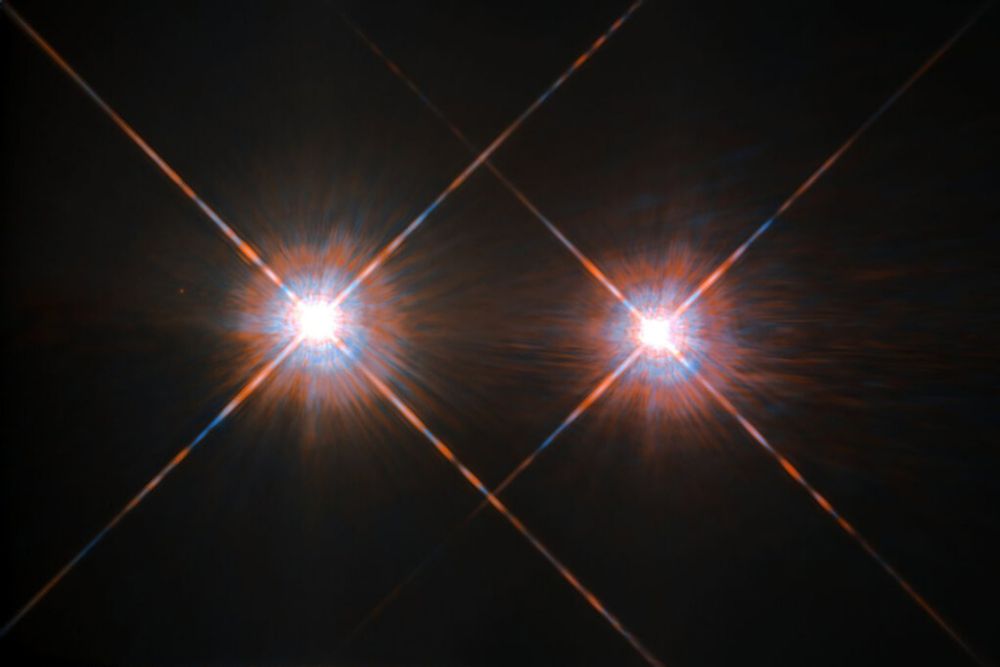
www.nytimes.com
This Is Not the Way We Usually Imagine the World Will End
Direct High-Resolution Imaging of Earth-Like Exoplanets astrobiology.com/2025/06/dire... #astrobiology #exoplanet
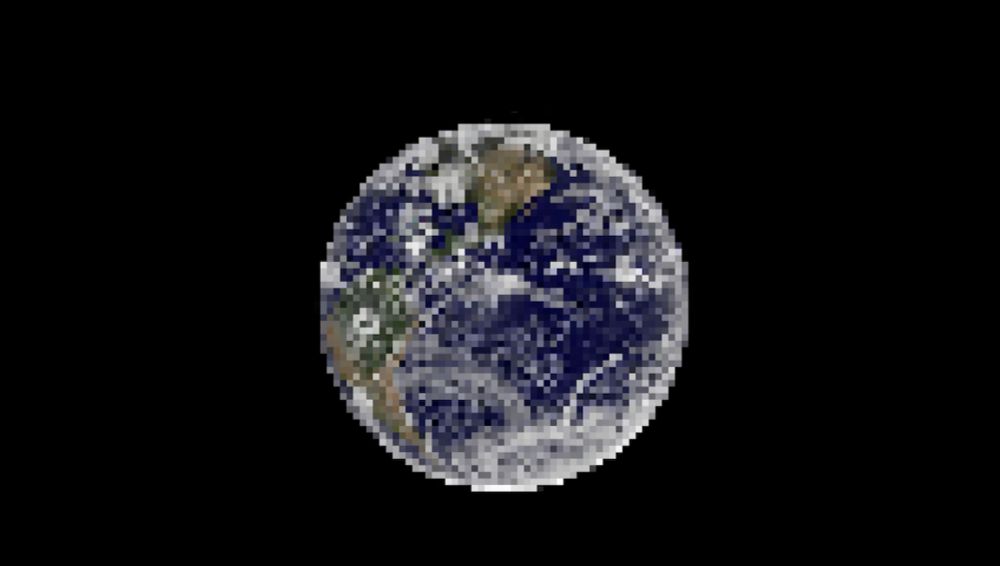
astrobiology.com
Direct High-Resolution Imaging of Earth-Like Exoplanets - Astrobiology
We have surveyed all conventional methods proposed or conceivable for obtaining resolved images of an Earth-like exoplanet.
Looking at a Saturn class world in formation around the star TWA 7. This is a JWST catch & not yet confirmed, but evidence is strongly supportive of a planet here, the smallest yet found via direct imaging. www.centauri-dreams.org/2025/06/27/j...
www.centauri-dreams.org
JWST Catch: Directly Imaged Planet Candidate | Centauri Dreams
Have you seen the Rubin Observatory's first images? Rubin has the largest digital camera in the world, and it's ready to revolutionize astronomy! Over the next decade, it will discover 2000x MORE galaxies than the 10 million shown below. Let's explore how its images compare to other telescopes 🔭
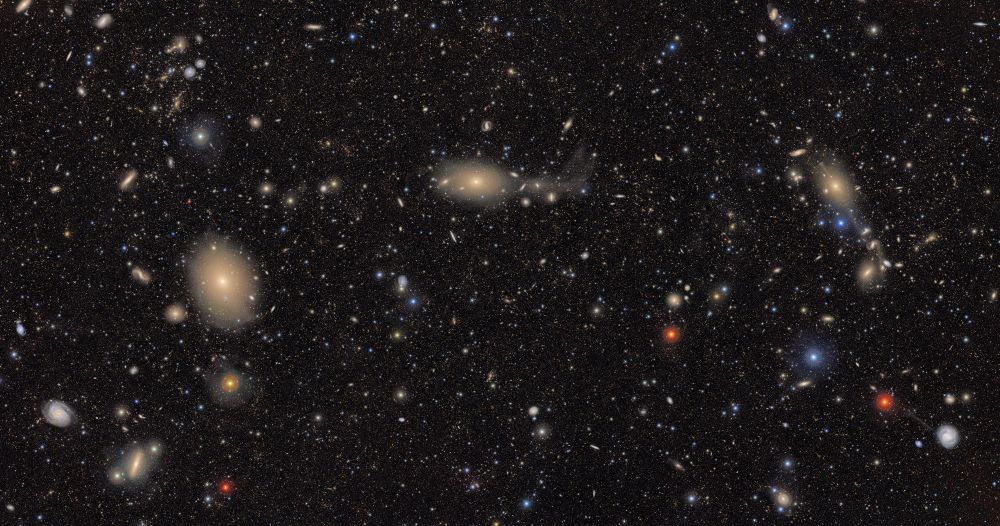
We’re reading: “Measurements of the force produced by a negatively charged electric sail in a pulsed cathodic arc plasma” pubs.aip.org/aip/pop/arti...

pubs.aip.org
Measurements of the force produced by a negatively charged electric sail in a pulsed cathodic arc plasma
Electric sails are a propellant-less spacecraft propulsion method that uses charged wires to deflect a flowing plasma in an environment such as the solar wind o
Introducing...your sneak peek at the cosmos captured by NSF–DOE Vera C. Rubin Observatory! Can you guess these regions of sky? This is just a small peek...join us at 11am US EDT for your full First Look at how Rubin will #CaptureTheCosmos! 🔭🧪 #RubinFirstLook ls.st/rubin-first-look-livestream
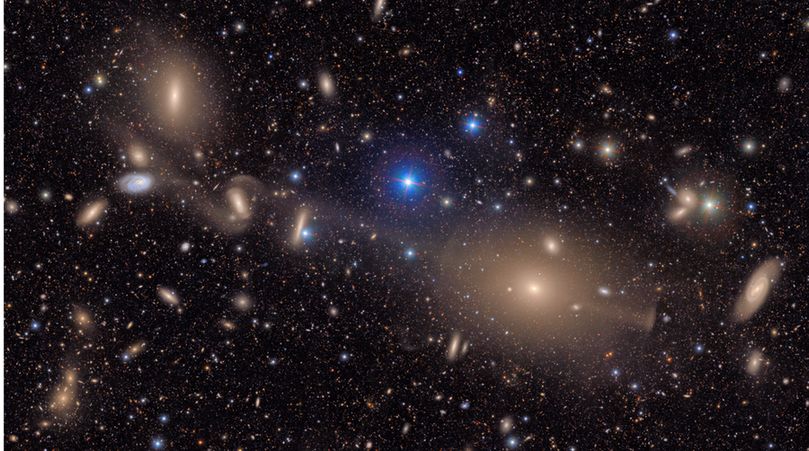
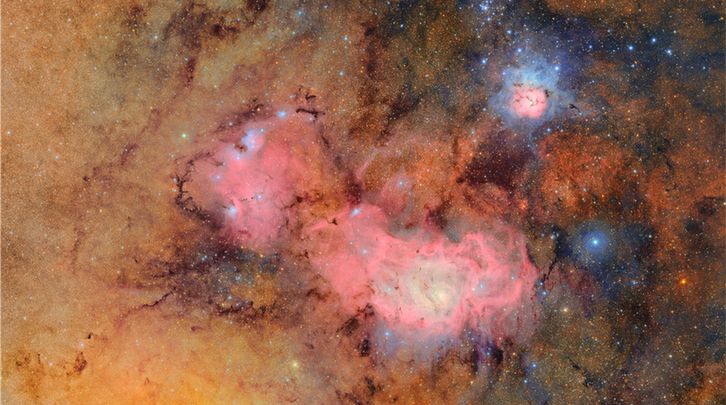
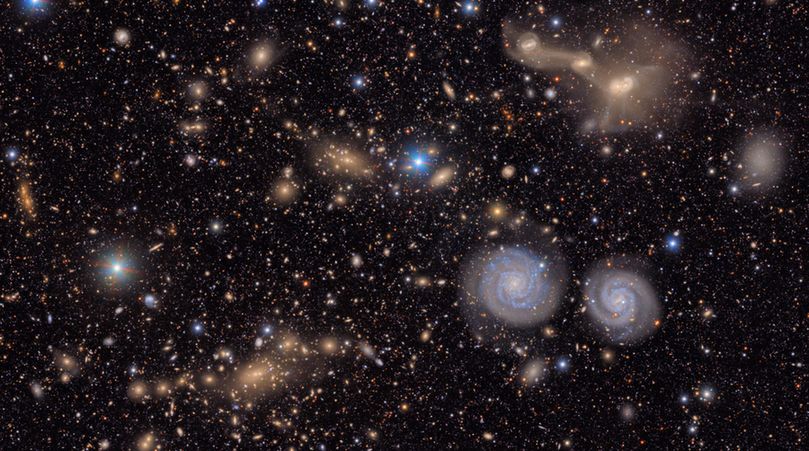
Astronautics propulsion often comes down to plumbing, and interstellar propulsion will be no exception. So we had Swagelok Québec bring their training trailer to campus and put our personnel through a valve & fitting bootcamp.

For the same reason, water fountains aboard O’Neill cylinders will be spectacular.

We’re reading “Study of Venera Spacecraft Trajectories and Wider Implications” by Adam Hibberd (@adamsspaceresearch.bsky.social) arxiv.org/pdf/2506.09478
arxiv.org
An inflatable beryllium solar sail for exploring the Oort Cloud: arxiv.org/pdf/0809.3535 150 kg sail, 150 kg payload, expanding to 937m diameter near the Sun (Be to survive 1412 K peak temperature) to get a boost outwards at 400 km/s, able to reach the heliopause in 2.5 years.

Registration is open for the 9th Interstellar Symposium in Austin, Texas, 12-15 October 2025. irg.space/2025-irg-9th...
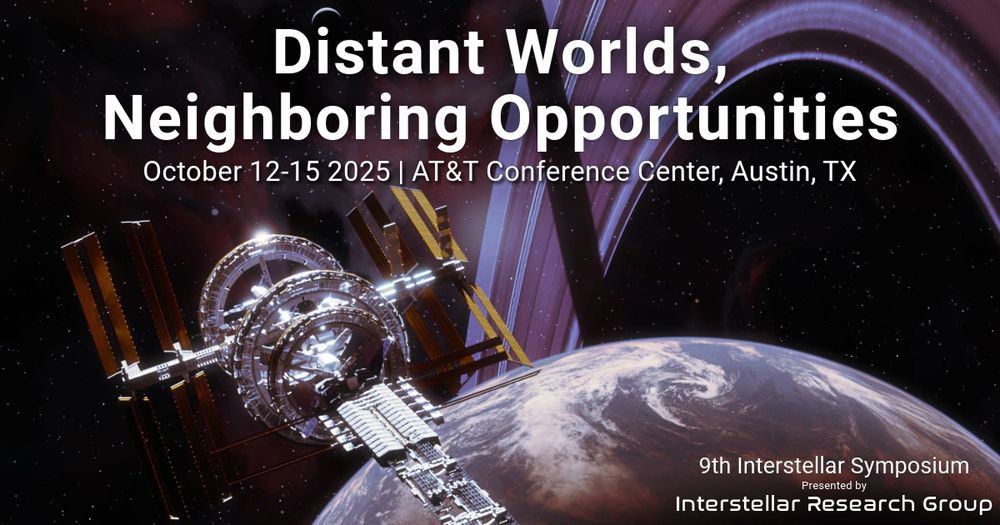
irg.space
2025 - Austin, Texas - Interstellar Research Group
Distant Worlds, Neighboring Opportunities An Interstellar Research Group EventOctober 12-15, 2025 AT&T Conference CenterUniversity of Texas at Austin CALL FOR PAPERS REGISTER TODAY HOTEL RESERVATION I...
Inflatable sails offer steep savings in mass & enable larger payloads. I look today at deep space concepts involving this technology, & new studies on using inflatable structures for exoplanet research via a starshade. www.centauri-dreams.org/2025/06/11/i...
www.centauri-dreams.org
Inflatable Technologies for Deep Space | Centauri Dreams
Here's another excellent video by @fcain.universetoday.com describing a breakthrough in light sail technology... youtu.be/iHLm9oHMsyM?...
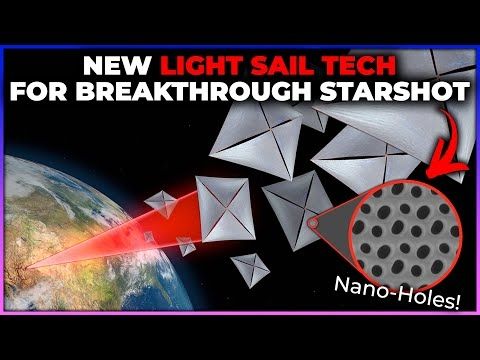
youtu.be
Punching NanoHoles in Light Sails Can Bring Us Closer to Alpha Centauri
YouTube video by Fraser Cain
The @vrubinobs.bsky.social will discover ~70% of all of its small body discoveries in it's first 2 years! A video animation of our discovery predictions - Further details sorcha.space

www.youtube.com
Simulated Solar System Discoveries of LSST
YouTube video by Jake Andrew Kurlander
Search for elusive "Planet Nine" takes surprising twist, astronomers say www.cbsnews.com/amp/news/pla...

www.cbsnews.com
Search for elusive "Planet Nine" takes surprising twist, astronomers say
U.S. astronomers hunting for "Planet Nine" have instead stumbled on what appears to be a new dwarf planet in the solar system's outer reaches.
Giant planets on wide, eccentric orbits (like putative Planet 9) may form when stars are embedded in their natal stellar clusters. Sims suggest a 1-5% chance of such planets forming in exoplanetary systems & up to 40% in the Solar System. https://bit.ly/4dD7VOi #AstroSci
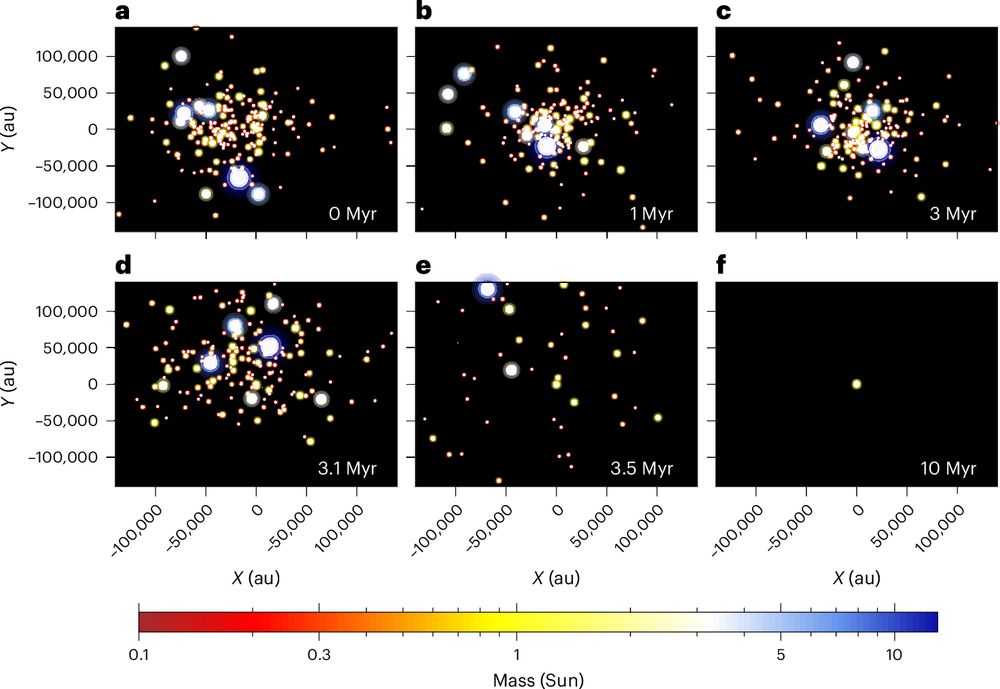
bit.ly
Very-wide-orbit planets from dynamical instabilities during the stellar birth cluster phase - Nature Astronomy
Giant planets on wide, eccentric orbits—like the putative Planet Nine—may form from dynamical planetary instabilities when stars are embedded in their natal stellar clusters. Simulations suggest a 1–5% chance of such planets forming in exoplanetary systems and up to 40% in the Solar System.
How many civilizations may have existed in the galaxy millions (or billions) of years before our own? Temporal coincidence may be an issue for detecting megastructures like Dyson swarms. New paper shows how they degrade over time. www.centauri-dreams.org/2025/05/29/m...
www.centauri-dreams.org
Megastructures: Adrift in the Temporal Sea | Centauri Dreams
Konstantin Batygin (Caltech): “The [2017 OF201] object is unstable, so it means virtually nothing for the Planet 9 hypothesis. [The simulations show] this object is strongly interacting with Neptune.” buff.ly/k8MCYIS

buff.ly
Another Dwarf Planet in Our Solar System?
A newly discovered object in the outer solar system, 2017 OF201, is the largest found in more than a decade.
An object called 2017 OF201 is shaking up our ideas about the outer zone of our solar system. It follows an extreme, 25,000-year orbit. It may be 1 of 100s of such bodies filling a seemingly vacant region. And its existence casts doubt on searches for Planet 9. 🧪🔭 www.ias.edu/news/extreme...

For operations in near-Earth space, here's a reminder: replacing those radiators with a thin-film solar photovoltaic array of the same size would result in a greater specific power (kW/kg).
May 28, 2025 at 6:01 AM UTCCan you comment on how the discovery of 2017 OF201—an extreme trans-Neptunian object (TNO) that does not exhibit a longitude of perihelion consistent with the clustering that originally inspired the Planet 9 conjecture—might change your assessment of the likelihood of Planet 9?
May 27, 2025 at 8:11 PM UTC"Do you think Planet 9 exists?" The observational evidence is limited by small number statistics. That's often enough for many to conclude, somewhere between unlikely and no. But, I lean further towards more-likely-than-not, and a new paper out today helps explain why I've thought this way. 1/7
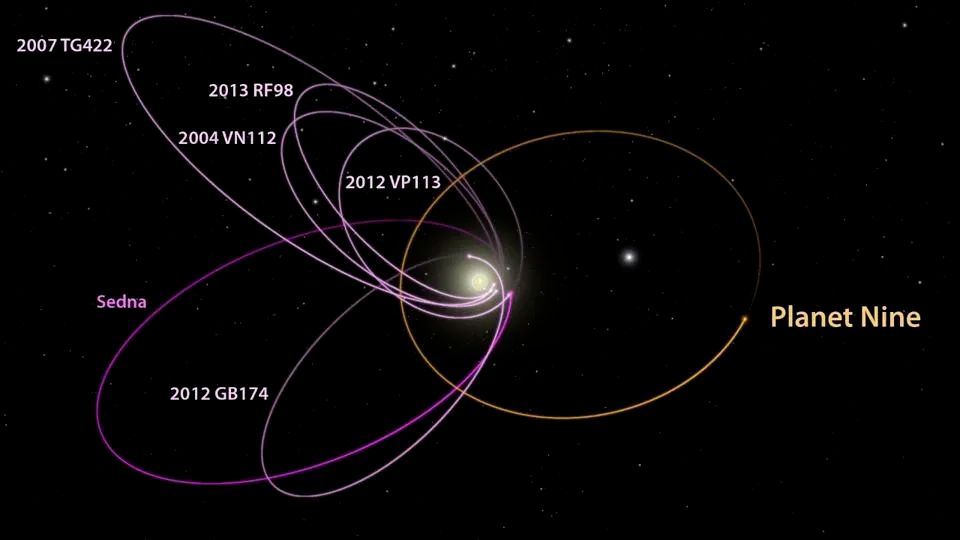
Four Planets Discovered Around Barnard's Star astrobiology.com/2025/05/four... #astrobiology #exoplanet #astronomy

astrobiology.com
Four Planets Discovered Around Barnard's Star - Astrobiology
Astronomers confirm the existence of small, hot and likely rocky planets by observing the subtle gravitational wobbles of the star they orbit.
The orbit would be disrupted by Planet 9 according to the paper, I’m not sure yet if there’s a way for Planet 9 to product a transitory population like the Centaurs.
May 25, 2025 at 7:45 PM UTCThis is fascinating work. A possible new dwarf planet has been spotted at the edge of our solar system and it only comes to visit every 25,000 years or so. 🧪 Its unusual orbit is also evidence against the existence of the hypothetical Planet 9. Read more here: www.newscientist.com/article/2481...
May 23, 2025 at 8:22 AM UTC“By demonstrating that 90-day transfers are feasible using existing chemical propulsion technology, our work provides a near-term, practical alternative to proposed nuclear thermal or nuclear electric propulsion solutions that have low TRLs and require significant regulatory approval processes.”
May 23, 2025 at 1:47 PM UTCWe’re reading “3 months transit time to Mars for human missions using SpaceX Starship” www.nature.com/articles/s41...

www.nature.com
3 months transit time to Mars for human missions using SpaceX Starship - Scientific Reports
Scientific Reports - 3 months transit time to Mars for human missions using SpaceX Starship
The second of a three-parter; in this post I look at the cinematic spaceship DISCOVERY, hero ship of 2001: A SPACE ODYSSEY, and the real-world 1960s gas-core nuclear rocket plans that might have made it possible. From No Shortage of Dreams. 🛰️🔭🧪🚀🪐🌏🌔👩🚀 spaceflighthistory.blogspot.com/2016/07/coul...

spaceflighthistory.blogspot.com
Could the Space Voyages in the Film and Novel "2001: A Space Odyssey" Really Happen? (Part 2)
The story of spaceflight told through missions and programs that did not happen - that is, the great majority of them.
Looking for biosignatures is already controversial & will continue to be so. But a null detection can be a useful thing in any case. Alex Tolley examines how we use Bayesian statistics to better understand the probability of life elsewhere. www.centauri-dreams.org/2025/05/23/t...
www.centauri-dreams.org
The Statistically Quantitative Information from Null Detections of Living Worlds: Lack of positive detections is not a fruitless search | Centauri Dreams
Can you comment on the implications for Planet 9? It doesn’t appear follow the perihelion clustering that inspired the Planet 9 conjecture. In the arXiv paper, N-body simulations using the P-9 model of Siraj et al. (2025) show this ETNO would be ejected in ~100 million years but is stable w/o P-9.

If confirmed, this new extreme TNO could spell trouble for the Planet 9 hypothesis. It doesn’t follow the perihelion clustering that inspired the Planet 9 conjecture. N-body simulations using P-9 model of Siraj et al. (2025) show this ETNO would be ejected in ~100 million years.

🚨 New dwarf planet candidate: 2017 OF201 🚨 ~700 km wide, now 90.5 AU from the Sun. Orbit: a = 838 AU, q = 44.9 AU — deep into the inner Oort Cloud. Possibly part of a hidden population totaling ~1% of Earth’s mass. 📄 Paper: arxiv.org/pdf/2505.15806 #astronomy #dwarfplanet

https://arxiv.org/abs/2505.15806 "Notably, the orbit of 2017 OF201 lies well outside the clustering of longitude of perihelion observed in extreme trans-Neptunian objects, which has been proposed as dynamical evidence for a distant, undetected planet." (Time to make some plots with this brand […]
mastodon.social
Original post on mastodon.social
Two key figures: This newly discovered extreme TNO does not conform to the clustering of the perihelion longitudes that led to the Planet 9 hypothesis. Using the Planet 9 model of Siraj et al. (2025) in N-body simulations, this new ETNO would be ejected in ~100 million years.

We’re reading “Discovery of a dwarf planet candidate in an extremely wide orbit: 2017 OF201” Key quote: “The orbit of 2017 OF201 also presents an intriguing challenge to the Planet X / Planet 9 hypothesis.” arxiv.org/abs/2505.15806

arxiv.org
Discovery of a dwarf planet candidate in an extremely wide orbit: 2017 OF201
We report the discovery of a dwarf planet candidate, 2017 OF201, currently located at a distance of 90.5 au. Its orbit is extremely wide and extends to the inner Oort cloud, with a semi-major axis of ...
Exoplanet Detection With Microlensing astrobiology.com/2025/05/exop... #astrobiology #astronomy #exoplanet

astrobiology.com
Exoplanet Detection With Microlensing - Astrobiology
Microlensing is the method of exoplanet detection that discovers solar system analog exoplanets.
ToughSF is back! A new blog post: The Laser Revolution Part I: Megawatt beams to the skies toughsf.blogspot.com/2025/05/the-...

Just listening to the Voyager 1 signal on a Wednesday evening. More than 23 light hours away (25 billion km). Of course with the historic @radiotelescoop.bsky.social!
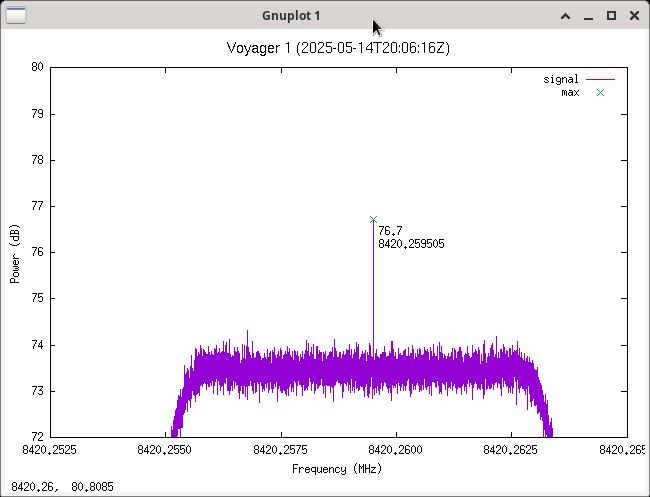
A visual look at two possible orbits for Planet Nine—one based on @plutokiller & @kb4batygin’s model, the other inspired by a recent IRAS/AKARI paper (arXiv:2504.17288) by @takao_nakagawa, @AmosChen, @frosztfang, @NomisOh, and @seongjin_torres.

Microlensing data from KMTNet suggests that rocky super-Earth planets are common far from their star, in orbits like Jupiter: arxiv.org/abs/2504.20158 In fact, there would be 0.35 'distant Earths' per star, compared to the general 1-planet-per-star ratio.

These are real images of exoplanets. Four super-Jupiters, imaged 10 times over 12 years around a star 133 lightyears away. These are real, giant worlds, out there in the dark. And we can see them.

Reconstructing The Free-floating Planet Mass Function With The Nancy Grace Roman Space Telescope astrobiology.com/2025/05/reco... #astrobiology #exoplanet #astronomy

astrobiology.com
Reconstructing The Free-floating Planet Mass Function With The Nancy Grace Roman Space Telescope - Astrobiology
ree-floating planets comprise one of the most enigmatic populations of exoplanets in the Galaxy.
A vast molecular cloud turns up much closer to the Sun than the Orion Nebula. Its discovery is a marker for how we're beginning to chart nearby interstellar space, a prerequisite if we are ever to navigate regions of dust and gas at a percentage of lightspeed. www.centauri-dreams.org/2025/04/29/c...
www.centauri-dreams.org
Charting the Interstellar Medium | Centauri Dreams
I have a couple of thoughts about the new paper the finds a candidate Planet Nine in some old data. First, it is difficult to tell how seriously to take this because a false alarm probability is never discussed, and second, if it is real, it is not Planet Nine. Read on: 🧵🔭🧪 arxiv.org/abs/2504.17288
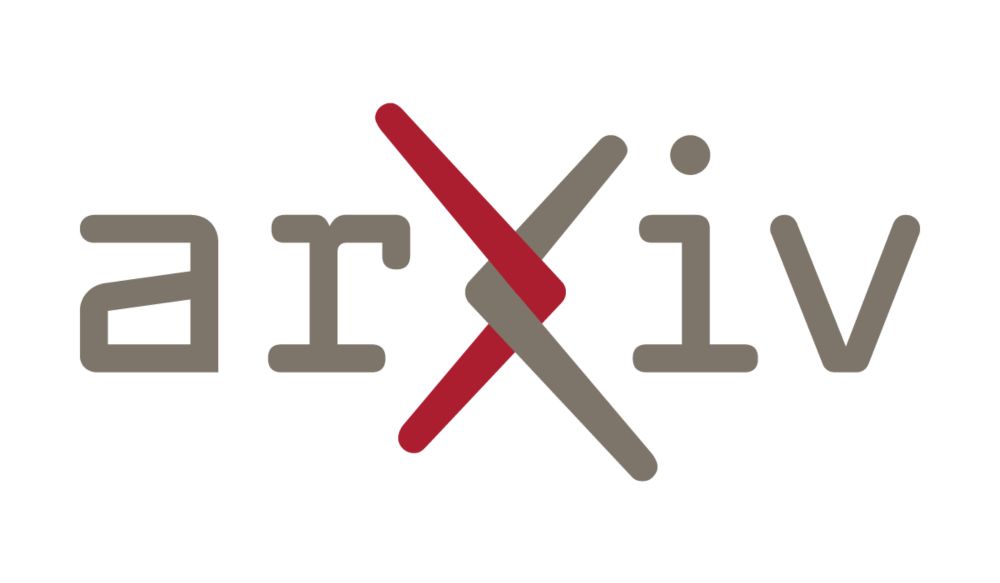
arxiv.org
A Search for Planet Nine with IRAS and AKARI Data
The outer solar system is theoretically predicted to harbour an undiscovered planet, often referred to as P9. Simulations suggest that its gravitational influence could explain the unusual clustering ...
NEA Scout failed, ACS3 didn't deploy, LightSail-1 never sailed and LightSail-2 barely raised its orbit while tumbling. What's next for solar sails? Are there any other missions planned?


It is tiny, but the Alpha CubeSat from Cornell University is heading to orbit this summer and will deploy a ChipSat lightsail. youtu.be/yQ5ndggAYz4?...

youtu.be
Alpha CubeSat is on the way to Houston! 🚀 #engineering #cornelluniversity
YouTube video by Cornell Engineering
JWST data are shaping our view of 'sub-Neptune' planets. Maybe the ocean world hypothesis needs a second look. This is part 2 of my examination of where the debate now stands. www.centauri-dreams.org/2025/04/22/t...
www.centauri-dreams.org
TOI-270 d: The Clearest Look Yet at a Sub-Neptune Atmosphere | Centauri Dreams
K2-18b just may be a water world under a hydrogen atmosphere, the category dubbed 'hycean' for hydrogen/ocean. Interesting detection of potential biosignatures here, but let's scrutinize carefully. Some thoughts: www.centauri-dreams.org/2025/04/18/a...
www.centauri-dreams.org
A Possible Biosignature at K2-18b? | Centauri Dreams
If Planet Nine exists, this is how we will find it, either through direct observation or by identifying a statistically significant number of TNOs that support the Planet Nine hypothesis.
April 17, 2025 at 12:49 PM UTC“…it is unlikely chemical signatures (even from in situ measurements!) will be convincing enough for us to announce the discovery of life.” Which means—to verify discovery of life on an exoplanet—we are going to need to *go* *there*.
April 17, 2025 at 12:33 PM UTCSarah’s rules of looking for life with only chemical signatures: 1) the smaller the molecule(s) the more likely they can also be produced by abiotic processes 2) one molecule, if it can be produced by any abiotic process, will never be enough to definitively claim detection of life
April 17, 2025 at 12:10 PM UTCThis is the iridium target used at CERN's Antimatter Factory. The Proton Synchrotron's 3.5 GeV beam is diverted to strike it, releasing a spray of radiation from which antiprotons are extracted. Extremely inefficient, but we don't know better. indico.cern.ch/event/105632...

Laser-Accelerated Plasma Propulsion System at 100,000s Isp: www.mdpi.com/2076-3417/11... Intense laser pulses strike a solid target, creating such strong electric fields that ions are ejected at high velocity via TNSA acceleration. It has many advantages over a pure photon rocket.




Could you elaborate a bit more on this? Our (admittedly undergraduate) understanding of electromagnetism is that static magnetic fields ultimately permeate most media. How, then, would the electron beams be shielded from the ambient magnetic fields?
March 27, 2025 at 4:44 PM UTCBy far the most terrifying interstellar weapon: a radiation beam, delivered by ultra-relativistic electrons that can penetrate deep into Earth's crust and thoroughly sterilize the planet... No shield, no warning or escape, invisible. @kurzgesagt.org: youtu.be/tybKnGZRwcU

Thus, from a star 42 light years away, the beam would make several loops before reaching Earth (if it can reach it at all). Fluctuations in the magnetic field of the interstellar medium would result in the beam being completely incoherent by the time it reaches Earth. Are we missing something?
March 27, 2025 at 2:44 PM UTCWe have difficulty making the numbers for the interstellar ultrarelativistic electron beam work. Even with a β=v/c=0.99999999999999999999999999998, an electron will still spiral around the magnetic field of the galaxy (B ~ 3 µT) with a radius of curvature of ~10 light years.
March 27, 2025 at 2:44 PM UTC🚀 All of the hyperbolic spacecraft currently escaping the solar system. Explore them in this interactive, pan-able browser simulation: orbitsimulator.com/gravitySimul...

Attendees at the 8th Interstellar Symposium in 2023 received a preview of this research that you can view here: www.youtube.com/watch?v=hmRn...

www.youtube.com
Propelling Interstellar Exploration: Extreme-Aspect-Ratio Metamaterials in Post-Moore Era
YouTube video by Interstellar Research Group
We're reading: “Pentagonal photonic crystal mirrors: scalable lightsails with enhanced acceleration via neural topology optimization” #OpenAccess www.nature.com/articles/s41...

www.nature.com
Pentagonal photonic crystal mirrors: scalable lightsails with enhanced acceleration via neural topology optimization - Nature Communications
Here the authors develop large-scale nanomaterials to improve the performances of laser propulsion using an easily scalable structure, thus bringing us closer to relativistic travel to our closest sta...
It's been an exciting couple weeks for the exploration of planets around other stars. First up: *Direct* images of planets orbiting two young, nearby stars. HR 8799 (left) has four super-Jupiters. 51 Eridani (right) has a planet 4 times the mass of Jupiter. 🧪🔭 webbtelescope.org/contents/new...


Currently, state-of-the-art photovoltaics achieve power levels of only kilowatts per kilogram (kW/kg), making it challenging to envision achieving another three orders of magnitude in power density.
March 13, 2025 at 1:15 PM UTCThis is only true if your power conversion system, which transforms the delivered laser power into electricity, can achieve a power density of megawatts per kilogram (MW/kg). Otherwise, the system is just too heavy to accelerate in a timely way.
March 13, 2025 at 1:15 PM UTCIf your target velocity for an interstellar probe is 0.2C, then the optimal Isp is 3,800,000s, better delivered by a laser-electric drive than a direct laser-propelled lightsail: www.geoffreylandis.com/Laser_ion.htp This continues to be true up to about 0.5C.

Amid the numerous groundbreaking scientific contributions yet to come, if Planet Nine exists, the LSST at @vrubinobs.bsky.social will be the instrument to discover it—either directly or indirectly.
March 13, 2025 at 12:40 PM UTCWe’re reading “Four Sub-Earth Planets Orbiting Barnard’s Star from MAROON-X and ESPRESSO” doi.org/10.3847/2041...
doi.org
Antimatter propulsion concepts: arc.aiaa.org/doi/10.2514/... The most interesting designs are the solid-propellant rocket with ablative LiH walls reaching 1400s Isp, and the 'pellet drive' reaching 1,000,000s Isp with good TWR in the region of 0.1-1




Our #AreciboWow! project is conducting the most in-depth analysis of the Wow! Signal using results from the world’s longest-running SETI initiative. Excited to welcome @hectorsocas.bsky.social & @davidkipping.bsky.social to the team! 📡🔭✨ #Astronomy #SETI

It is now routine to hear proponents like Robert Zubrin (@zubrin.bsky.social) and Peter Diamandis argue that knowledge will be the primary export of space settlements. Today, I stumbled across a 1970 talk by Arthur Kantrowitz, in which he made the exact same point. A man truly ahead of his era.

Research at Caltech under Harry Atwater tracks silicon nitride lightsail proxy's reaction to laser beam. This kind of work is crucial if we are to use beamed energy to push sails to high velocities. Can we get to Proxima b? Choice of sail materials is crucial. www.centauri-dreams.org/2025/03/03/s...
www.centauri-dreams.org
Shaping the Sail: Metamaterials and the Manipulation of Light | Centauri Dreams
Oh, and did we forget: The 7th largest telescope ever built…operating 1 million miles from Earth.
March 1, 2025 at 3:53 PM UTCA good day for the DSN to remind us of what we are capable of at our best: Simultaneously communicating with three spacecraft at Mars, a mission en route to Europa to look for life, another heading to the Jovian Trojan asteroids, and our two furthest interstellar envoys.

To make a beamed sail interstellar mission possible, we need plenty of experimental work on sail materials of all kinds. Today I review previous work and look toward questions we need to answer about laser & microwave beaming: www.centauri-dreams.org/2025/02/27/e...
www.centauri-dreams.org
Experimenting on an Interstellar Sail | Centauri Dreams
Antimatter: Scientists freeze positronium atoms with lasers www.bbc.com/news/science...

www.bbc.com
Antimatter: Scientists freeze positronium atoms with lasers
Positronium has the potential to revolutionise physics but the elusive substance had been too hot to handle.
Life as a series of 'hard steps' may make extraterrestrial civilizations unlikely. But do 'hard steps' really exist? New work reconsiders Brandon Carter's famous paper in light of evolutionary environmental change. Good news for SETI? www.centauri-dreams.org/2025/02/21/s...
www.centauri-dreams.org
SETI’s Hard Steps (and How to Resolve Them) | Centauri Dreams
We’re reading “Ringworlds and Dyson spheres can be stable” by Colin McInnes arxiv.org/abs/2502.12806

arxiv.org
Ringworlds and Dyson spheres can be stable
In his 1856 Adams Prize essay, James Clark Maxwell demonstrated that Saturn's rings cannot be comprised of a uniform rigid body. This is a consequence of the two-body gravitational interaction between...
Official Artwork for IRG 2025 Symposium Released! This breathtaking piece represents our theme: “Distant Worlds, Neighboring Opportunities.” Learn more: irg.space

Given vistas opening through our telescopes & probes, what would surprise you the most about what we may find in the galaxy? I'm homing in on basic questions of life's formation, curious to know what our core assumptions are. How do they color our research? www.centauri-dreams.org/2025/02/14/w...
www.centauri-dreams.org
What Would Surprise You? | Centauri Dreams
New research suggests that material from Alpha Centauri has reached our Solar System, mostly in the form of tiny rocks. The study modeled how particles ejected from Alpha Centauri, which is moving towards us, could travel through space and reach the Oort Cloud. 1/2 👉 arxiv.org/pdf/2502.03224

Our first “Earth-like” exoplanets probably won’t have atmospheres With JWST, we're finally able to start probing Earth-sized planets within about 50 light-years for atmospheres. Here's why it's very unlikely that we'll find any. bigthink.com/starts-with-... #space #astro #astronomy #science

bigthink.com
Our first "Earth-like" exoplanets probably won't have atmospheres
Seeking life beyond the Solar System, we first look to the closest star systems with Earth-like planets. Here's why that's not good enough.
Earth Detecting Earth astrobiology.com/2025/02/eart... #astrobiology #exoplanet #SETI #technosignature
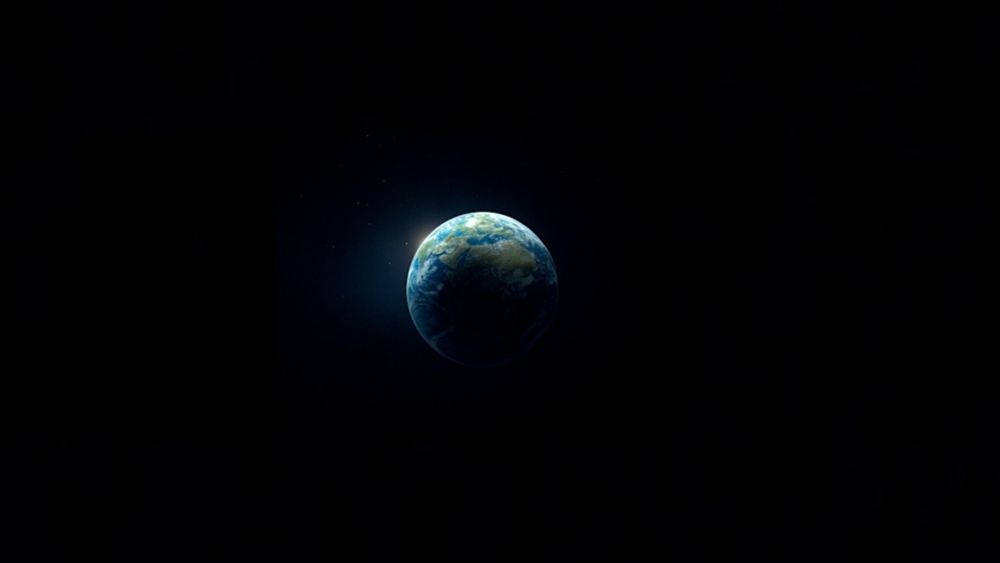
astrobiology.com
Earth Detecting Earth - Astrobiology
If an extraterrestrial civilization existed with technology similar to ours, would they be able to detect Earth and evidence of humanity?
Mason Peck's idea of using Lorentz-actuated flybys of planetary magnetospheres offers a potentially innovative (and free!) method for reaching the speeds required for interstellar travel. However, a charge-to-mass ratio of 10 C/kg is insanely large for anything bigger than a speck of dust.
February 5, 2025 at 3:23 PM UTCGravity-Assist maneuvers using electrically charged spacecraft: arc.aiaa.org/doi/10.2514/... A probe that can add or remove an overall charge of 1-10 C/kg can exploit the Lorentz force when interacting with the target planet's magnetic field without expending propellant.




Just what constitutes a technosignature? The possibilities go far beyond radio & Dyson spheres. New paper digs into what may eventually be detectable, quantifying the possibilities. Fascinating work that pins down what we do know, & what we don't. www.centauri-dreams.org/2025/02/05/q...
www.centauri-dreams.org
Quantifying the Chances of a Technosignature | Centauri Dreams
New book blog post! Tau Zero, by Poul Anderson! skullsinthestars.com/2025/02/02/t...

skullsinthestars.com
Tau Zero, by Poul Anderson
Book 7 for my 2025 goal of 30 books for the year! I love a good science fiction story that really leans into one of the weird aspects of modern physics, and so as soon as I learned the premise of P…
We’re reading “Analyzing the acceleration time and reflectance of light sails made from homogeneous and core-shell spheres” #OpenAccess doi.org/10.1364/OME....
t.co
https://opg.optica.org/ome/fulltext.cfm?uri=ome-15-2-345
Asteroid fragments upend theory of how life on Earth bloomed www.nature.com/articles/d41...

www.nature.com
Asteroid fragments upend theory of how life on Earth bloomed
Samples from Bennu contain the chemical building blocks of life — but with a twist.
Please do go to my recent starship blog for the 'Initiative for Interstellar Studies' (i4is). i4is.org/tunguska-and...
lnkd.in
This link will take you to a page that’s not on LinkedIn
Searching for extraterrestrial intelligence across a century - IOPscience https://iopscience.iop.org/article/10.1088/1742-6596/2877/1/012050
January 23, 2025 at 12:40 PM UTCThank you so much for this! I am glad to hear that the research direction is still bearing fruit.
January 8, 2025 at 8:06 PM UTCPropelling Interstellar Exploration: Extreme-Aspect-Ratio Metamaterials in Post-Moore Era Prof. Richard Norte, TU/Delft youtu.be/hmRnk0BV3OA?...

youtu.be
Propelling Interstellar Exploration: Extreme-Aspect-Ratio Metamaterials in Post-Moore Era
YouTube video by Interstellar Research Group
You can view talks from the Breakthrough Starshot-funded research presented at the Interstellar Symposium here: Starshot From Science to Spacecraft and Missions Prof. Harry Atwater, Caltech youtu.be/jV2sNOYzaFA?...

youtu.be
Starshot From Science to Spacecraft and Missions
YouTube video by Interstellar Research Group
To further clarify, our research group is not affiliated with Breakthrough Starshot, although we inhabit the same research circles. In July 2023, we hosted the 8th Interstellar Symposium in Montreal, where many of the research results from Breakthrough Starshot were reported.
January 8, 2025 at 4:19 PM UTC(2) Demonstrating that inexpensive fiber-optic lasers or solid-state lasers can be phased-locked to form a phased array, effectively acting as a single optical element of arbitrarily large size.
January 8, 2025 at 4:19 PM UTC(1) Demonstrating that photonic sail materials can be fabricated in the lab with a combination of high reflectivity and, more importantly, low absorptivity, allowing them to withstand the laser flux necessary for a laser-driven interstellar light sail.
January 8, 2025 at 4:19 PM UTCTo clarify, the 2016 Breakthrough Starshot initiative was *not* intended to directly fund the development of an interstellar probe, but rather to assess its technological feasibility. Significant progress was made under this effort, including:
January 8, 2025 at 4:19 PM UTCIn various interviews from 2024 available online, Pete Worden (Executive Director of the Breakthrough Starshot) has stated that the initial phase of Breakthrough Starshot has concluded, and further research is on pause while they write up the results from the preliminary studies.
January 8, 2025 at 4:19 PM UTCDid a heavy iron cover on an underground nuclear blast in 1957 get blown clear out of the Solar System? Almost certainly not. In fact, the odds on its reaching space are tiny. Comments from one involved as well as calculations: www.centauri-dreams.org/2025/01/07/a...
www.centauri-dreams.org
A Manhole Cover Beyond the Solar System? | Centauri Dreams
The Hard-Science SF Writers and Artists Group kicks off their 2025 speaker series this Saturday with science fiction scholar Marleen S. Barr. I will be presenting on September 6th about science fiction and space exploration. Registration: tinyurl.com/4a48hce4 YouTube Channel: tinyurl.com/3wcwx24x

www.youtube.com
Tucson Hard-Science SF Channel
Welcome to the Tucson Hard-Science Fiction SF Channel. Here we will share some of our great Zoom speakers and other fine science fiction content. We hope you will join our virtual science fiction co...
Encouraging signs: Data is being transmitted down from the Parker Solar Probe via the Deep Space Network following its record-setting perihelion on December 24.

Here's a great video by Isaac Arthur on the Medusa Spaceship Drive, an interesting concept for interstellar propulsion. It's a variant of the Orion drive, similarly using nuclear explosions but with several claimed advantages... youtu.be/MNkc-PCwSNo?...

youtu.be
The Medusa Spaceship Drive
YouTube video by Isaac Arthur
Interstellar trajectory: Re-examination of idea that goes back to beginning of Voyager mission. A tank-emptying final burn, a symbolic gesture bending their courses towards the vicinity of nearest star to each. A kind of requiem, a promise to keep exploring. www.centauri-dreams.org/2024/12/24/h...
www.centauri-dreams.org
Interstellar Reprise: Voyager to a Star | Centauri Dreams
Experimental Tests Of The Calibration of High Precision Differential Astrometry for Exoplanets astrobiology.com/2024/12/expe... #astrobiology #astronomy #exoplanet
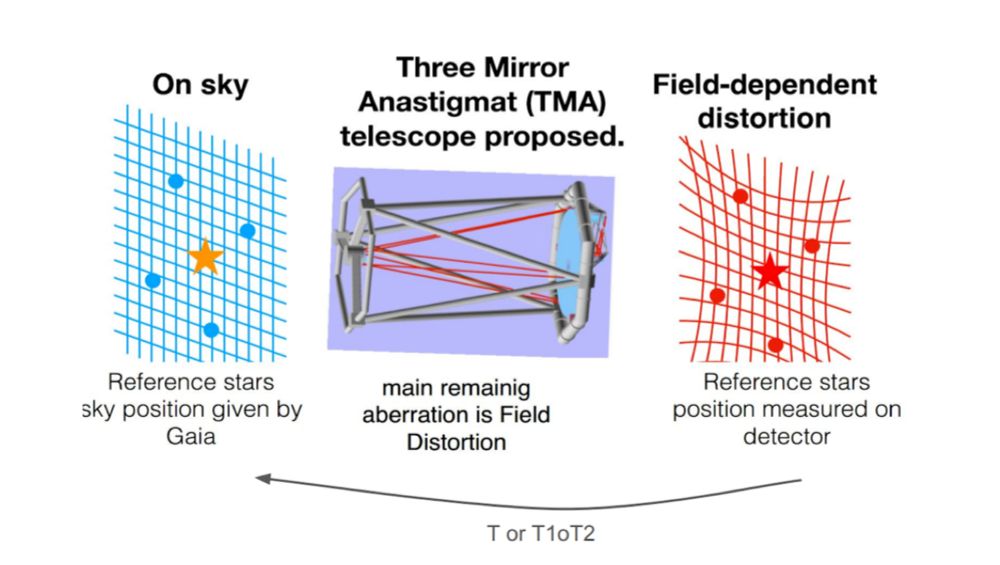
astrobiology.com
Experimental Tests Of The Calibration of High Precision Differential Astrometry for Exoplanets - Astrobiology
High precision differential Astrometry is the branch of astronomy that evaluates the relative position
A wonderful piece on Ed Stone, and what it takes to PI a whopping mission of discovery. Ed was the scientific lead of the Voyager missons. www.nytimes.com/interactive/...

www.nytimes.com
How Edward Stone Resolved NASA’s Scientific Turf Wars (Gift Article)
To run a scientific expedition that travels billions of miles, it takes more than great engineers — it takes a great manager as well.
Due to it's closest approach yet to the Sun and the phenomenon of gravitational assist (aka gravitational 'slingshot'), the Parker Solar Probe just became the fastest human-made object at ~ 690,000 km/hr (430,000 mi/hr). This is ~ 192.22 km/sec (119.44 mi/sec) – only 0.000641 of the speed of light.
December 26, 2024 at 6:32 PM UTCHappening on Xmas Eve: Parker Solar Probe's first-ever closest approach to the Sun, at a distance of only 9.86 solar radii, is scheduled for ~11:45 UT on Dec 24, 2024. This animation shows the trajectory of Parker's Encounter 22 projected onto the solar equatorial plane ☀️🛰️ #heliophysics #parker

Earlier today, the Parker Solar Probe set two space records: closest approach to the Sun, and fastest-ever human object, hitting a speed of 191 km/sec. 🧪 parkersolarprobe.jhuapl.edu

On the occasion of the #ParkerSolarProbe reaching perihelion (closest approach to the Sun) earlier today, I put together a 1:30 scale paper model of the spacecraft I got at the #AGU24 conference. There was a full scale model of Parker at the @jhuapl.bsky.social booth at AGU. tinyurl.com/4t8ahbyz




Good discussion of warp drive feasibility by @adamfrank4.bsky.social starting here: t.co/B91E8jcQfN
t.co
https://youtu.be/yhZAXXI83-4?si=PvE1kTnW5hMBal5E&t=6435
On Christmas Eve, the #ParkerSolarProbe will make its closest pass ever to the Sun, flying at a record-breaking 191 km/s! 🌞 It will pass just 6.1 million km above the Sun's photosphere, navigating through the scorching corona. 🔥

Because I believe human migration into the Solar System & beyond is inevitable, a new paper on preserving already existing space artifacts has my attention. Anthropology meets space tech, and also encounters legal questions. We need to think long-term. www.centauri-dreams.org/2024/12/18/c...
www.centauri-dreams.org
Charting the Diaspora: Human Migration Outward | Centauri Dreams
Interstellar objects are a lot of fun to work on. Feels like a few different ideas are all getting to a good place
December 16, 2024 at 9:23 AM UTCThe classic Relativistic Rocket accelerates at 1g to the edge of the speed of light: 2.3 years to Alpha Centauri (4.2 ly) 10 years to the center of the Milky Way (26,000 ly) 15 years to Andromeda (2,500,000 ly), reaching a level of time dilation where 1 second = 1 month

The 'Hypertelescope': a concept for creating telescopes of unlimited size using arrays of small mirrors, 25 km wide inside a lunar crater or as a 100,000 km diameter laser-trapped flotilla, with a prototype in a French valley. hypertelescope.org/hypertelesco... hypertelescope.org/wp-content/u...



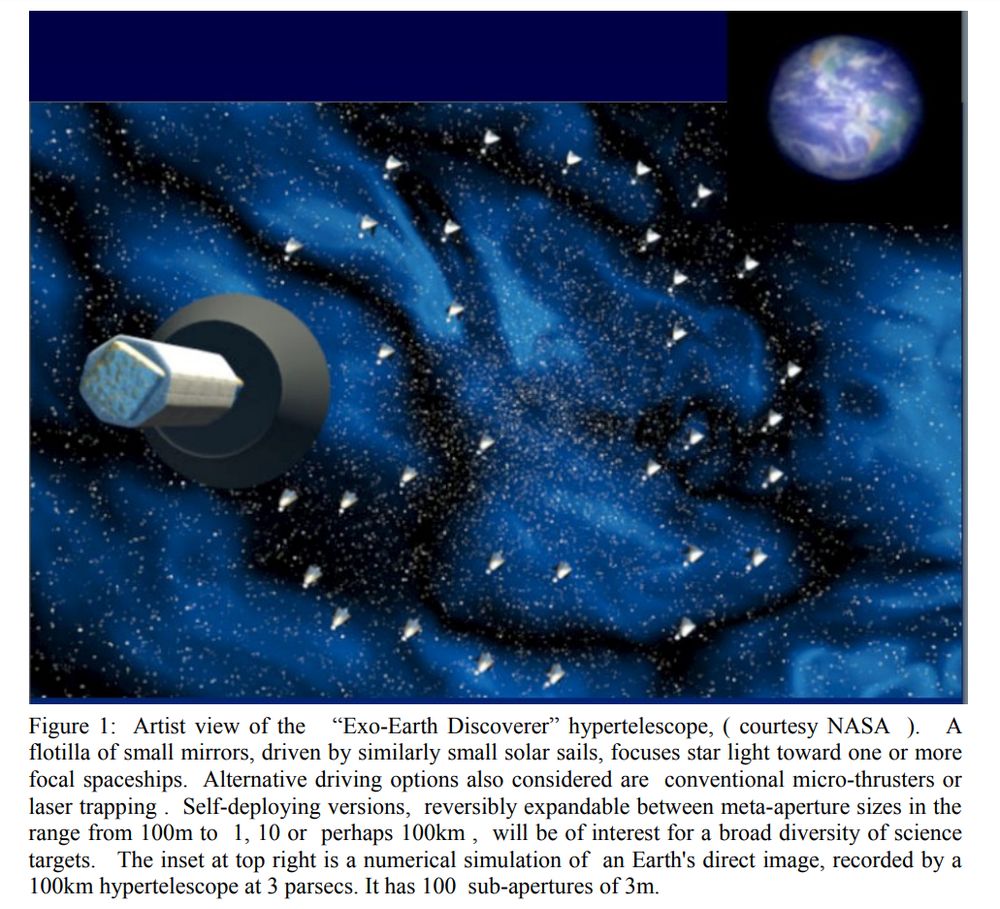
If a technology can move entire stars, what observational signal will this throw? Spectral signatures for a galaxy change if lower-mass stars are gradually enveloped in Dyson Spheres to generate energy for their eventual 'harvesting.' Life in a high-end civ: www.centauri-dreams.org/2024/12/04/a...
www.centauri-dreams.org
Autumn Among the Galaxy Clusters | Centauri Dreams
Great conversation by Everyday Spacer with our collaborator Jeff Greason. While the discussion starts with space policy, it quickly pivots to Jeff's work on interstellar propulsion. Also, thanks for the shout-out to our laser thermal propulsion work! www.youtube.com/live/gBpxotu...
www.youtube.com
YouTube
Share your videos with friends, family, and the world
NEID Earth Twin Survey Delivers On Its Goal to Push the Limits of Exoplanet Discovery astrobiology.com/2024/11/neid... #astrobiology #exoplanet #astronomy #Imaging

astrobiology.com
NEID Earth Twin Survey Delivers On Its Goal to Push the Limits of Exoplanet Discovery - Astrobiology
For four years the NEID spectrograph has been delivering on one of its main science goals.
Scenes from the #DaydreamingInTheSolarSystem book launch at the Merril Collection of Science Fiction, Speculation, and Fantasy: Author @arcticsaxifrage.bsky.social and illustrator Michelle Parsons, John in conversation with astronomer Sarah Rugheimer, and my copy autographed. tinyurl.com/3cxbn9x2



Spotlight on SETI: Episode 3 with Dr. Pascal Lee www.seti.org/spotlight-se... #astrobiology #astrogeology @setiinstitute.bsky.social
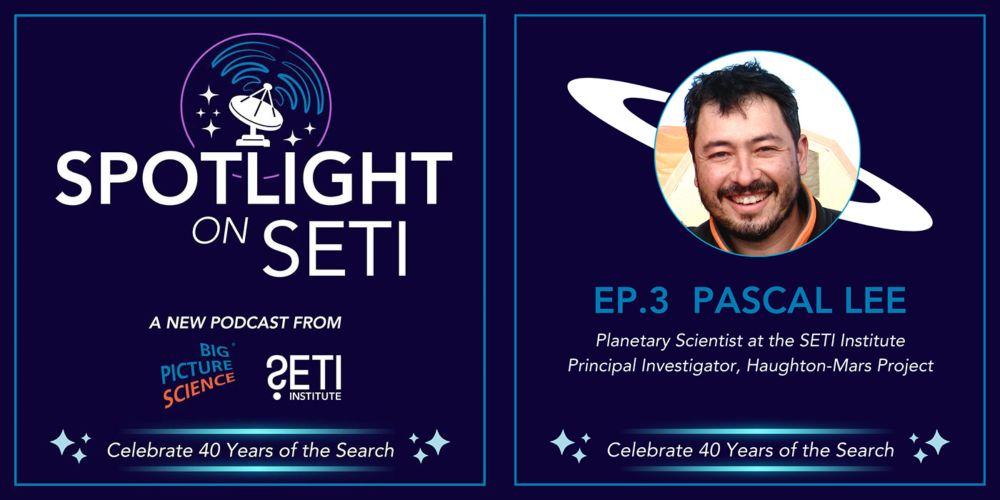
www.seti.org
Spotlight on SETI: Episode 3 with Dr. Pascal Lee
The book launch for #DaydreamingInTheSolarSystem is tomorrow at the Merril Collection of Science Fiction, Speculation and Fantasy in Toronto. Written by @arcticsaxifrage.bsky.social and Jesse Rogerson, the book takes readers from the craters of Mercury to the icy dunes of Pluto. tinyurl.com/4m9r3twa

Huge lasers as the only plausible option for propellant spacecraft to relativistic speeds, using phased arrays like DELTA that can be expanded from grams to tons of payload: www.sciencedirect.com/science/arti... There's also a fun 1000 ton, 10 PW Avatar ISV example with 36 km reflector to reach 0.7C




We’re Building a Generation Ship. All We Need Is ... Everything. Care to Help? 💡🌌 Project Hyperion invites YOU to submit designs for an interstellar generation ship. Go to projecthyperion.org for details. #projecthyperion #interstellar #generationship Image: @macspace.bsky.social
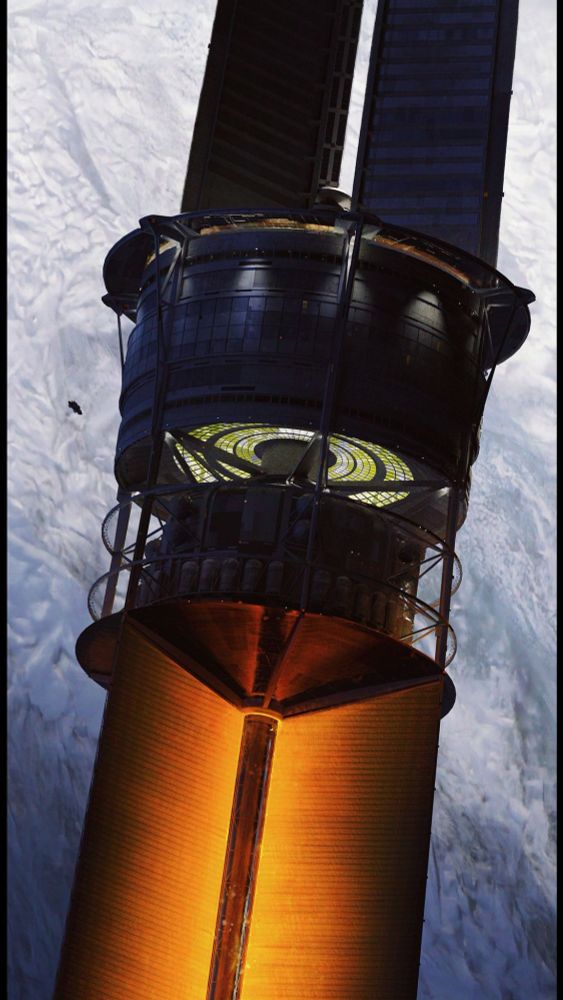
Preparations for NASA's Habitable Worlds Observatory 🔭🪐 (HWO) are well underway. Planned to launch in the 2040s, this 'Super-Hubble' will revolutionise astrophysics and survey at least 25 potentially habitable exoplanets for signs of alien life. 👾 This week we held a HWO workshop in Baltimore. 🧵

🧵on the Habitable Worlds Observatory - which in addition to astrophysics and exoplanets - will absolutely ROCK for Solar System studies #planetsci
November 21, 2024 at 12:46 AM UTCMillisecond pulsars as stellar engines, but with what payload? Part II of my post on Clément Vidal's 'spider engine,' a way of moving entire stars. Can advanced cultures do this & work with neutron stars themselves as hosts for intelligence? www.centauri-dreams.org/2024/11/19/s...
www.centauri-dreams.org
Star Harvest: Civilizations in Search of Energy | Centauri Dreams
Congratulations @bsky.app on reaching 20 million users. I think you might just make it. (h/t @natalie.sh for the counter)

Our group has created a Start Pack for interstellar flight researchers and enthusiasts, along with the journalists, YouTubers, and podcasters who cover their work. go.bsky.app/9cA6F93

Interstellar Flight Starter Pack
Starter pack by McGill Interstellar Flight Research Group
Interstellar flight researchers and enthusiasts, along with the journalists, YouTubers, and podcasters who cover their work. If you wish to be removed or added to this list, please DM us.
Have decided to move to BlueSky for good, having left X for obvious reasons. Future posts from my Centauri Dreams site will be linked here. Current post considers Clément Vidal's striking concept for using millisecond pulsars to move entire stellar systems. www.centauri-dreams.org/2024/11/14/a...
www.centauri-dreams.org
A Millisecond Pulsar Engine for Interstellar Travel | Centauri Dreams